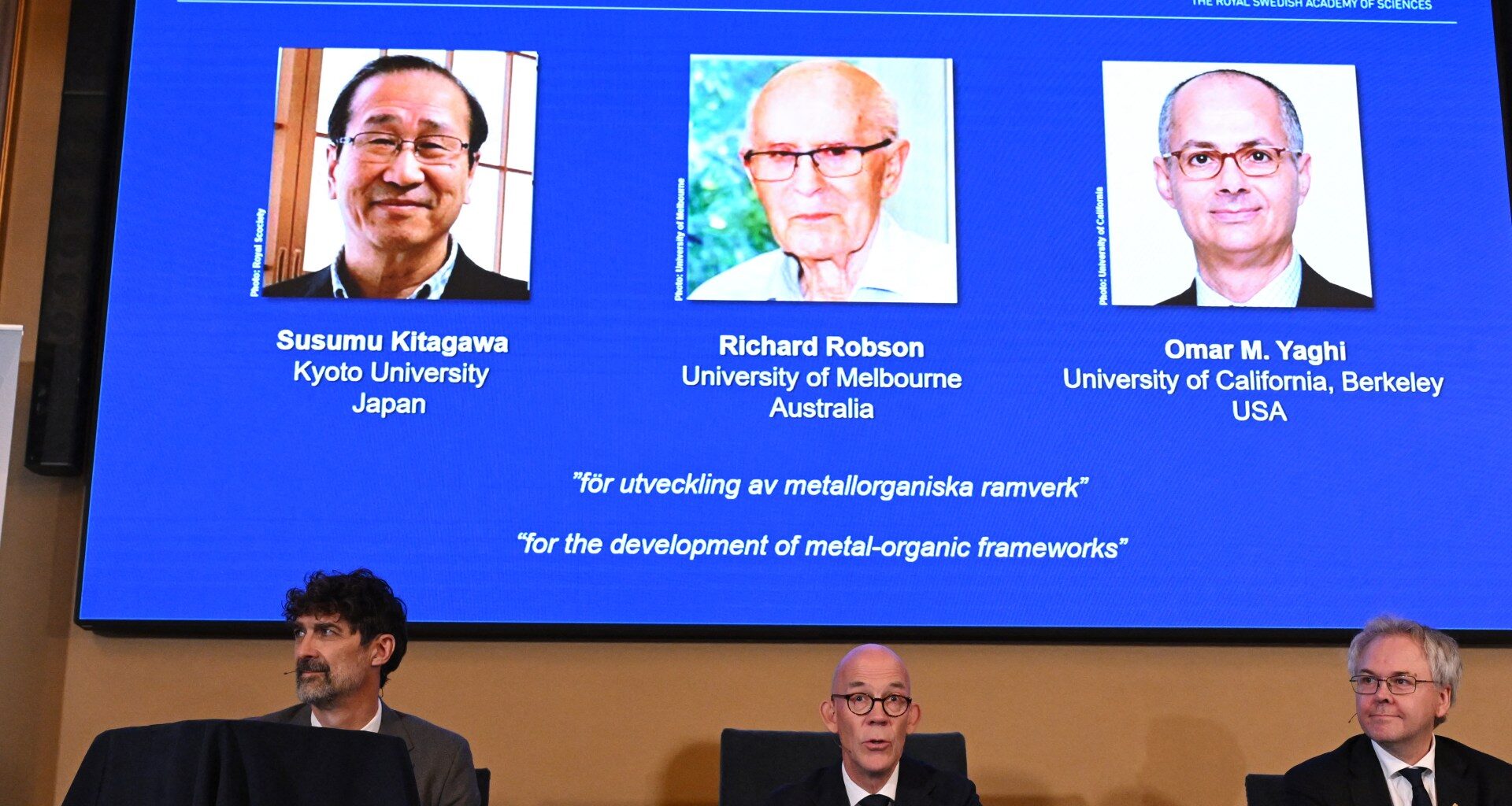The Royal Swedish Academy of Sciences has awarded the 2025 Nobel Prize in chemistry to Susumu Kitagawa, Richard Robson and Omar M Yaghi for their work in the development of metal organic frameworks (MOF).
The three scientists, who won the award on Wednesday, come from the universities of Kyoto in Japan, Melbourne in Australia and Berkeley in the United States, respectively.
Recommended Stories list of 3 itemsend of list
The trio have created “molecular constructions with large spaces through which gases and other chemicals can flow”, read a statement from the Nobel Prize. Such constructions can be used to harvest water from desert air, capture carbon dioxide, store toxic gases or break down traces of pharmaceuticals in the environment.
“Metal organic frameworks have enormous potential, bringing previously unforeseen opportunities for custom-made materials with new functions,” said Heiner Linke, chair of the Nobel Committee for Chemistry.
According to Olof Ramstrom, a member of the Nobel Committee for Chemistry, the new form of molecular architecture can be compared with the handbag of the fictional Harry Potter character Hermione Granger: small on the outside but very large on the inside.
Kitagawa told the Nobel press conference that he was deeply honoured by the award: “My dream is to capture air and separate air to – for instance, in CO2 or oxygen or water or something – and convert this to useful materials using renewable energy”.
Yaghi was born to Palestinian refugees in Jordan, where his family shared a one-room home with the cattle the family was raising. “It’s quite a journey and science allows you to do it,” he said in an interview published on the Nobel website, adding that his parents could barely read or write. “Science is the greatest equalising force in the world,” he said.
Yaghi, who said he was astonished and delighted to win the award, was 10 years old when he found a book on molecules in the library, and it was the beginning of a life-long love of chemistry. “The deeper you dig, the more beautifully you find things are constructed,” he told the Nobel website.
The chemists, working separately but adding to each other’s breakthroughs, devised ways to make stable metal organic frameworks, which may be compared with the timber framework of a house.
These structures can absorb and contain gases inside these frameworks, with many practical applications today — such as capturing carbon dioxide from the atmosphere or sucking water out of dry desert air.
The first step into what would have been a decades-long journey was in 1989 when Robson tested atoms’ properties in a new way, combining positively charged copper ions with a four-armed molecule. This had a chemical group that was attracted to copper ions at the end of each arm, reads a description in the Nobel Prize’s statement.
When they were combined, they formed a shape similar to a diamond filled with cavities. But the crystal would collapse easily. That is when Kitagawa and Yaghi entered the frame. Working separately between 1992 and 2003, they made a series of discoveries to make the metal frameworks stable. Kitagawa showed that they could be made flexible while Yaghi discovered that they can be modified using rational design.
“We named Kitagawa and Yaghi Citation Laureates in 2010, based on their exceptional citation records in the Web of Science — a clear signal, even then, of their profound influence on the field, said David Pendlebury, head of research analysis at the Institute for Scientific Information at Clarivate.
“Their highly cited papers reflected a rapidly expanding area of research, already two decades in the making at that time. Notably, both have been named Highly Cited Researchers every year since 2014, demonstrating that their contributions have not only stood the test of time but have continued to shape and lead the field as it has grown,” Pendlebury said.
The first Nobel of 2025 was announced on Monday. The prize in medicine went to Mary E Brunkow, Fred Ramsdell and Dr Shimon Sakaguchi for their discoveries concerning peripheral immune tolerance.
Tuesday’s physics prize went to John Clarke, Michel H Devoret and John M Martinis for their research on the weird world of subatomic quantum tunnelling that advances the power of everyday digital communications and computing.
This year’s Nobel announcements continue with the literature prize on Thursday. The Nobel Peace Prize will be announced on Friday, and the economics prize next Monday.
The award ceremony will be held on December 10, the anniversary of the death of Alfred Nobel, who founded the prizes. Nobel was a wealthy Swedish industrialist and the inventor of dynamite. He died in 1896.
